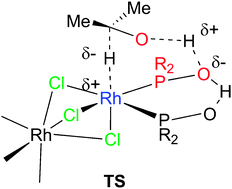In this new Catalysis Science & Technology Hot Article, Piet van Leeuwen et al. describe their investigation into the H-transfer activity of secondary phosphine oxide (SPO) complexes. The key feature is the heterolytic transfer of the two hydrogens as H+ to the O of P=O, and H- to the metal. They found that rhodium SPO complexes yielded active and enantioselective catalysts, which was supported by DFT calculations.
SPOs act as ligands in their trivalent phosphinous acid tautomeric form. Their metal-to-phosphorus bond is comparable in strength to that of phosphines and they are often used as monodentate ligands, but more often as bidentate and tridentate ligands towards transition metals connected via their oxygen atoms by protons or hard metals.
Read more about these new ligands for free until 29th March 2011, here.
SPOs as new ligands in Rh(III) catalyzed enantioselective transfer
hydrogenation
Pascal M. Castro, Henrik Gulyas, Jordi Benet-Buchholz, Carles Bo,
Zoraida Freixa and Piet W. N. M. van Leeuwen
Catal. Sci. Technol., 2011, Advance Article, DOI:10.1039/C0CY00022A











